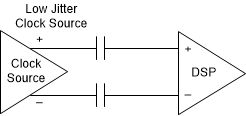SPRACL9 May 2019 66AK2E05 , 66AK2H06 , 66AK2H12 , 66AK2H14 , AM5K2E02 , AM5K2E04 , TMS320C6652 , TMS320C6654 , TMS320C6655 , TMS320C6657 , TMS320C6670 , TMS320C6671 , TMS320C6672 , TMS320C6674 , TMS320C6678
- KeyStone Multicore Device Family Schematic Checklist
5.2.4 Clock Termination
Most input clocks are presumed to be of the differential type and require proper terminations or coupling. Each differential pair must be AC-Coupled using a 0.1 μF ceramic capacitor (0402 size or smaller recommended). In some cases, depending on topology, a 1-μF capacitor can be used. All AC-coupling capacitors should be located at the destination end as close to the device as possible. For more information, see AC-coupling between differential LVPECL, LVDS, HSTL, and CML.
 Figure 2. Clock Termination
Figure 2. Clock Termination